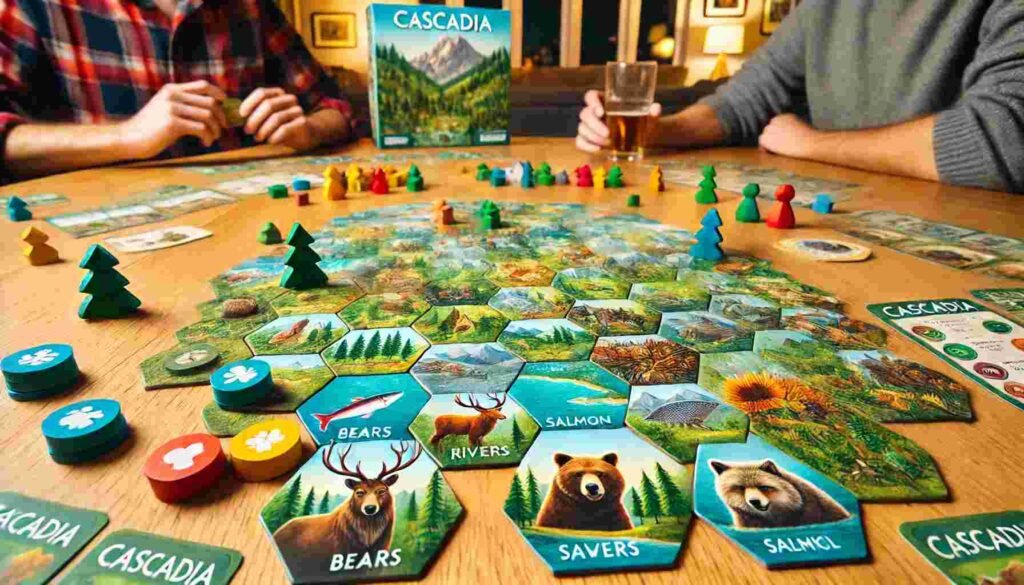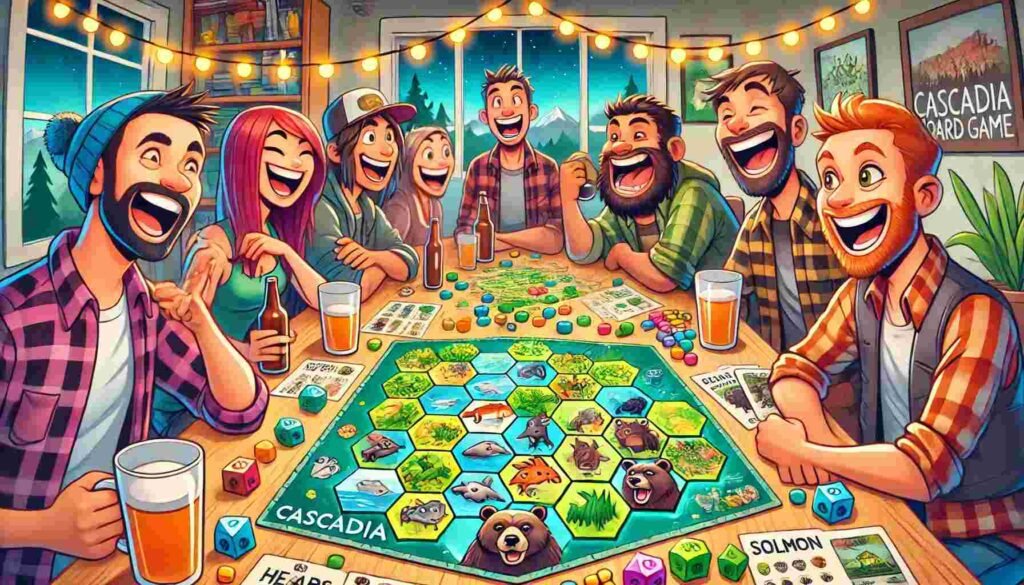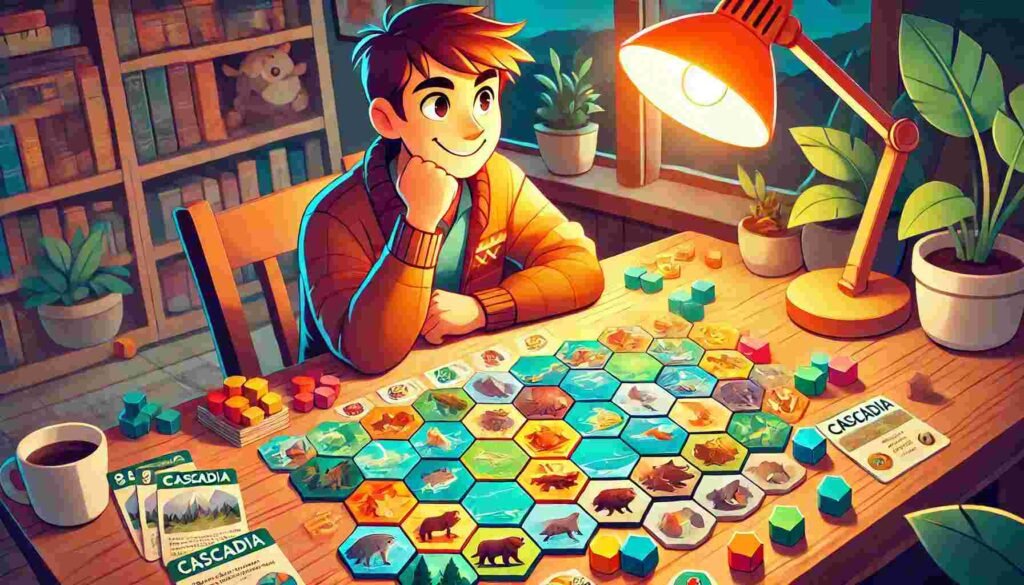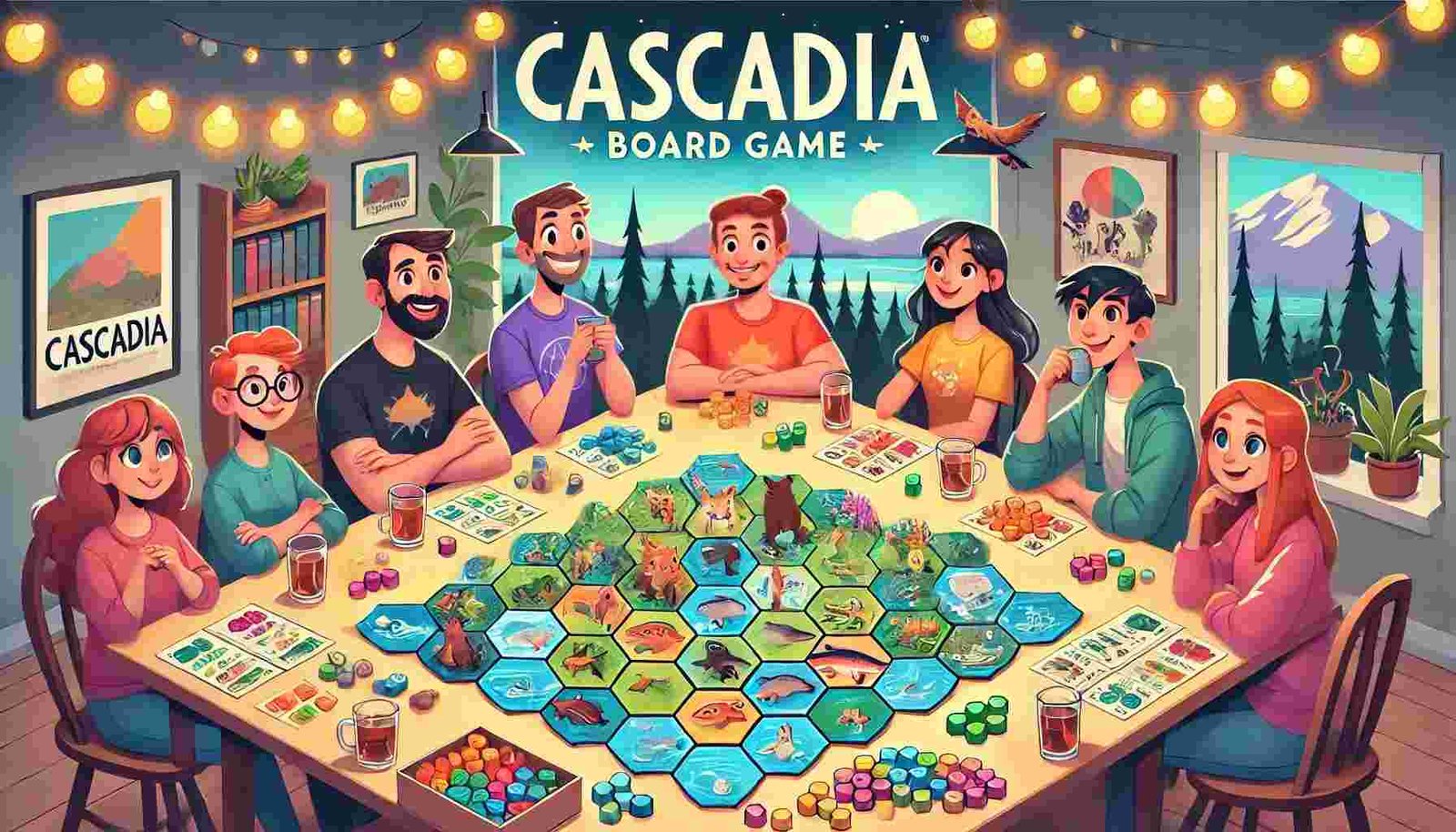Dive into the Cascadia board game, where strategy meets beautiful nature. Inspired by the Pacific Northwest, Cascadia lets you build habitats and explore stunning biodiversity. Play solo for a calm challenge or spice it up with a fun drinking party!
Table of Contents
What Is Cascadia Board Game?
Cascadia board game is a tile-laying and token-drafting game where players create habitats and populate them with wildlife. The objective is to score points by meeting specific goals for wildlife arrangements and creating large, contiguous regions of the same habitat type. Each decision you make helps shape your personal landscape while challenging you to balance competing priorities.
Why Cascadia Shines
Cascadia board game isn’t just a fan favorite; it’s a critical darling. Ranked among the top 100 on BoardGameGeek, it has earned accolades like the Mensa Select Award and the prestigious Spiel des Jahres (Game of the Year) in 2022. With such credentials, it’s clear that Cascadia belongs in every board game collection.

How to Play Cascadia Board Game
Components and Their Roles
1. Habitat Tiles
- Description: Hexagonal tiles depicting one or two habitat types: forests, mountains, rivers, wetlands, and prairies.
- Features: Each tile has icons for one to three animals that can be placed there.
- Key Use: Habitat tiles form the foundation of your landscape and determine where wildlife can thrive.
2. Wildlife Tokens
- Description: Wooden discs representing bears, elk, salmon, hawks, and foxes.
- Features: Each wildlife token matches specific icons on the habitat tiles.
- Key Use: Placed on habitat tiles to fulfill scoring objectives based on wildlife scoring cards.
3. Wildlife Scoring Cards
- Description: Tarot-sized cards that detail how each species scores points.
- Features: Each animal has four unique cards, adding variability to the game.
- Key Use: Define the patterns and configurations needed to maximize points for each species.
4. Nature Tokens
- Description: Pinecone-shaped tokens that provide drafting flexibility.
- Key Use: Allow players to take mismatched habitat tiles and wildlife tokens from the draft row.
5. Starting Player Tiles
- Description: Large tiles featuring all six habitat types and a keystone habitat.
- Key Use: Provide a balanced starting point for each player.
6. Scorepad
- Description: Divided into two sections for wildlife and habitat scoring.
- Key Use: Tracks points and determines the winner.
Setting Up the Game
Step 1: Prepare the Habitat Tiles
- Select Tiles: Remove a specific number of tiles based on the player count:
- 2 Players: Remove 42 tiles (play with 43).
- 3 Players: Remove 22 tiles (play with 63).
- 4 Players: Remove 2 tiles (play with 83).
- Create Stacks: Shuffle the remaining tiles and divide them into face-down stacks.
Step 2: Prepare the Wildlife Tokens
- Place all wildlife tokens into the drawstring bag.
Step 3: Select Scoring Cards
- Randomly choose one scoring card for each species and place them face-up.
Step 4: Set the Draft Row
- Draw four habitat tiles and place them face-up in a row.
- Draw four wildlife tokens from the bag, assigning one to each habitat tile.
Step 5: Distribute Starting Tiles
- Each player receives one starting player tile at random.
Step 6: Ready the Nature Tokens
- Place all nature tokens in a central supply.
The game ends when the habitat tile stacks are depleted. Each player takes the same number of turns. Proceed to scoring to determine the winner.
Scoring and Winning
1. Wildlife Scoring
- Refer to the selected scoring cards to tally points for each species.
- Example Objectives:
- Bears: Points for pairs or family clusters.
- Foxes: Points for adjacency to diverse wildlife.
- Salmon: Points for unbroken runs.
- Hawks: Points for isolated placements away from other hawks.
- Elk: Points for straight lines or specific shaped patterns like clusters or triangles.
2. Habitat Scoring
- Score points for the largest contiguous region of each habitat type.
- Additional points are awarded for having the largest habitat corridors in each type:
- 2 Players: 2 points for the largest region, 1 for ties.
- 3–4 Players: 3 points for the largest region, 1 for second place.
3. Nature Tokens
- Each unspent nature token earns 1 point.
4. Winning the Game
- The player with the highest total score wins.
- Tiebreaker: The player with the most nature tokens left wins. If still tied, the victory is shared.

Cascadia Drinking Game Variations
Cascadia is a calm, strategic game, but with a little creativity (and maybe a few beverages), it can turn into a hilariously memorable party game. Below are innovative and fun variations for turning Cascadia into a drinking game that blends strategic thinking with a touch of wildness.
Basic Cascadia Drinking Game Rules
To keep things simple, here’s a basic framework for incorporating drinks into the gameplay:
- Each player starts with a beverage of their choice.
- Drinks are sipped, taken as shots, or finished based on specific game triggers (detailed below).
- Ensure everyone knows their limits and drink responsibly!
Variation 1: Keystone Chaos
Keystone habitats are central to Cascadia’s strategy, so naturally, they’re prime for drink-worthy moments!
- Keystone Placement: Every time you place a keystone habitat tile, choose someone to take a sip.
- Double Trouble: If you place a keystone tile and earn a nature token in the same turn, everyone drinks!
- Misplaced Token: If someone can’t place their wildlife token, they take two sips as “nature’s penalty.”
Variation 2: Wildlife Party
Each wildlife species gets its own rule, turning your ecosystem into a drinking zoo.
- Bears: Whenever you complete a pair of bears, growl dramatically. The last person to growl takes a drink.
- Elk: If you finish an elk group, everyone takes a sip to “cheer the herd.”
- Foxes: When placing a fox, compliment another player’s tile placement. If you can’t think of anything, take a drink.
- Salmon: Successfully creating a salmon run? Everyone cheers you with a sip. Fail to extend a run? Take two drinks.
- Hawks: Every time a hawk token is placed, all players must “hawk screech.” The player with the worst screech takes a drink.
Variation 3: Habitat Hijinks
Habitat tiles are your playground for drinks and mischief!
- Longest Corridor: Whenever you connect more than five tiles of the same habitat, nominate someone to take a sip.
- River’s Edge: If you place a tile next to a river, raise your glass and take a celebratory sip.
- End of the Line: If you create a disconnected habitat, take two drinks and apologize to your ecosystem.
Variation 4: Nature Token Shenanigans
Nature tokens offer flexibility, but they come with their own set of drinking rules!
- Spend a Token: Every time you use a nature token, you must toast to “nature’s bounty” and take a sip.
- Hoarder Alert: If you end the game with unspent nature tokens, take a drink for every token left.
- Token Steal: If someone steals a draft pair you clearly wanted, they take a penalty sip for being a “habitat thief.”
Variation 5: Scoring Spectacle
Turn the endgame scoring phase into a boozy celebration (or punishment).
- Highest Scorer: The player with the highest wildlife score nominates one player to finish their drink.
- Lowest Scorer: The player with the lowest habitat score takes a “penalty shot” (or finishes their drink if shots aren’t involved).
- Bonus Points Battle: For every bonus point earned, nominate someone to take a sip.
Variation 6: Speed Cascadia Shots
For faster play, add timed turns to the mix.
- Time Limit: Use a 60-second timer for each player’s turn, turning it into a “power hour” of rapid decisions. If they fail to complete their tile and token placement within the time, they take a shot.
- Shot Interruption: If a player places their token incorrectly and catches it after another player points it out, they take a penalty shot.

Cascadia Solo Play: A Tailored Experience for One
The solo mode in Cascadia offers a clever adaptation of the multiplayer experience, ensuring the game retains its depth and excitement even with just one player. Here’s what makes it stand out:
Streamlined Gameplay
In solo mode, players follow the same core mechanics as multiplayer, drafting habitat tiles and wildlife tokens to build their ecosystem. However, a unique “discard mechanism” simulates the competitive element of multiplayer games:
- At the end of each turn, the habitat tile and wildlife token on the far-right of the draft row are discarded.
- Two new pairs are drawn to replace the removed options, maintaining the balance of four available choices.
This adds an additional layer of strategy, as players must anticipate which resources they might lose and prioritize their selections accordingly.
Scoring Adjustments for Solo Play
While the rules for scoring wildlife patterns remain consistent, the habitat scoring introduces a twist to reward ambitious gameplay:
- Points are awarded for the largest contiguous region of each habitat type.
- Bonus Points: An additional 2 points are granted for each habitat containing seven or more tiles, encouraging players to expand their regions thoughtfully.
These adjustments make the solo mode more challenging and rewarding, as players strive to maximize both wildlife and habitat scores within a limited number of turns.
The Appeal of Cascadia’s Solo Mode
- Time-Efficient: A solo game takes only 20–25 minutes, making it a perfect choice for quick gaming sessions.
- Mental Engagement: The discard mechanism introduces dynamic decision-making, ensuring every turn feels meaningful.
- Relaxation and Focus: Cascadia’s nature-based theme and puzzle-like gameplay make solo play a calming yet mentally stimulating experience.
Challenges: Cascadia’s Built-In Replayability
To add further depth and variety, Cascadia includes 50 unique challenges that players can undertake in both solo and multiplayer modes. These challenges provide goals that range from simple achievements to complex scenarios, extending the game’s longevity.
Three Types of Challenges
1. Scenario Challenges
These challenges provide predefined scoring conditions and objectives.
- Objective Examples:
- Use specific combinations of wildlife scoring cards (e.g., the “Bear Clans” or “Salmon Runs” setups).
- Achieve target scores within these scenarios, such as earning at least 100 points with specific wildlife cards in play.
- Best For: Players who enjoy structured goals and experimenting with different scoring setups.
2. Normal Challenges
These challenges add an achievement system to regular gameplay.
- Examples:
- “Score at least 110 points.”
- “Earn 30 points from a single type of wildlife.”
- “Win a game without using any Nature Tokens.”
- Competitive Edge: In multiplayer games, only the winner earns credit for completing a challenge, fostering friendly competition.
- Solo Mode: Players track their progress independently, adding a sense of personal accomplishment.
3. Rule Restriction Challenges
These challenges modify the rules to introduce new levels of difficulty.
- Examples:
- Habitat corridors must contain at least five tiles to score.
- It takes two Nature Tokens to draft a mismatched pair of habitat tiles and wildlife tokens.
- Impact: These restrictions force players to rethink strategies, enhancing the replayability and complexity of the game.
Tracking Progress with the Challenge Trail
Cascadia includes a “Challenge Trail” system in its rulebook, allowing up to six players to record their achievements.
- Players color in milestones as they complete challenges, creating a sense of progression.
- Challenges can be revisited to improve performance, offering replay value and a competitive edge.
Other Great Tile-Laying Board Games
If you enjoy the strategic depth of Cascadia, there are plenty of other tile-laying games to explore:
- Carcassonne: A classic game where players build medieval landscapes with roads, cities, and fields while vying for strategic control.
- Isle of Skye: Combines tile-laying with an innovative auction mechanic, letting players create unique Scottish landscapes.
- Kingdomino: A fast-paced game where players draft domino-style tiles to build their kingdom and maximize points.
- Calico: From the creators of Cascadia, this game challenges players to create colorful quilts while meeting pattern and color goals.
- Azul: A visually stunning game where players draft tiles to create beautiful mosaics, balancing patterns and placement for strategic scoring.
Each game offers its own twist on the tile-laying mechanic, ensuring endless fun and variety for board game enthusiasts!
Cascadia: A Tile Placement Adventure
Cascadia’s charm lies in its elegant balance of simplicity and depth. It’s a game you can teach in minutes but spend a lifetime mastering. Whether you’re a nature enthusiast, a strategy lover, or just looking for a fun family game, Cascadia delivers on all fronts.
